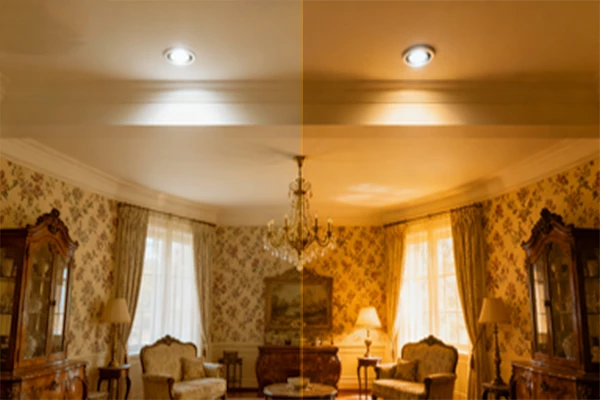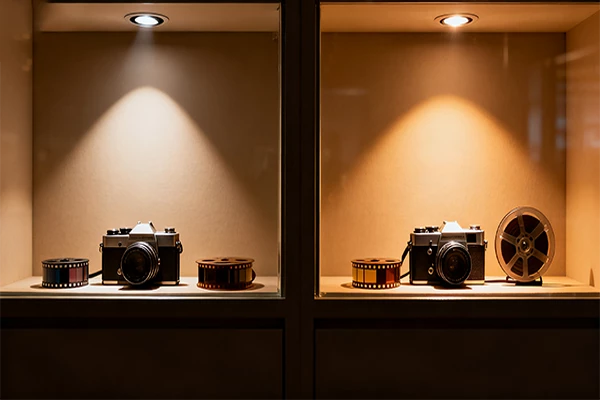Dim to Warm – Enjoy warm indoor sunshine during the cold winter
 A-ONE
A-ONE
 Oct 30,2025
Oct 30,2025

Ever dimmed your lights and felt a slight unease? The glow fades, yet turns pale and cold, draining the warmth from your room. This common issue reveals a flaw in traditional LED dimming: it only cuts brightness, ignoring the vital “temperature” of light.
In mid-to-high latitude regions like Northern Europe, Western Europe, and North America (e.g., Norway, Finland, Sweden, Germany, Northern Canada), winter brings lack of sunshine – or even polar nights. Artificial light quality directly shapes circadian rhythms and mood.
This is where Dim to Warm (DTW) dimming steps in. As you dim a DTW light, brightness drops and colour temperature smoothly warms – like sunset or candlelight. It recreates the natural, dynamic glow of incandescent bulbs, delivering a precious “artificial sunset” for homes in low-sunshine regions.
What is Dim to Warm
Dim to Warm (DTW) is an advanced LED dimming technology. When you dim a DTW light, brightness decreases while colour temperature automatically shifts from standard 3000K to a warmer tone (e.g., 2000K, like candlelight or sunset). Commonly used in LED spotlights, downlights, and architectural lighting.
How Does Dim to Warm Work
Traditional incandescent bulbs naturally Dim to Warm: lowering voltage cools the filament, reducing brightness and shifting the spectrum to warmer tones (from ~3000K to below 2000K).
LEDs lack this natural trait. Here’s how DTW achieves it:
Dim to Warm Technical Principle
- Dual-colour LEDs: one cool white group (4000K+), one warm white group (1800K–2200K)
- Dual-channel constant-current driver: supports leading-edge(triac), 0-10V, or PWM dimming
- Non-linear dimming curve: cool white: exponential fade (drops fast at low brightness);Warm white: linear or slow fade (retains output at low levels)
|
Brightness |
Cool White Current |
Warm White Current |
Mixed CCT |
|
100% |
100% |
100% |
3000K |
|
3% |
0% |
32% |
2000K |
Dim to Warm Technical Implementation
Users interact via a dimmer. DTW performance depends on the dimmer type – leading-edge is the market standard.
How it works
Turn or slide a standard dimmer knob. This alters the AC waveform (leading-edge dimming). The driver maps it to a single “brightness command”. Instead of uniform dimming, it adjusts the cool and warm LED ratios per a preset program. Light dims and warms simultaneously.
User Benefits
- Simple: no apps, no learning curve.
- Seamless: brightness and colour shift in perfect sync.
- Compatible: works with most existing household dimmer circuits – low upgrade cost.
Leading-edge dimming enables brightness-colour linkage, replicating incandescent warm-glow transitions – ideal for lack of sunshine or polar-night regions.
Why Choose DTW LED Lights in lack of Sunshine Regions
In Helsinki, Finland (1991–2020 climate normals), December sees just 30 hours of sunshine. Annual total: 1840 hours. Winter (Dec–Feb) daily average: 1.66 hours. This can disrupt circadian rhythms, lower mood, and cause eye strain.
Dim to Warn technology delivers human-centred lighting across four dimensions: circadian health, mental well-being, energy efficiency, and light quality.

Figure:Helsinki monthly average sunshine hours (1991–2020)
Source: Weather-and-Climate.com (Finnish FMI)
Link:https://weather-and-climate.com/average-monthly-hours-Sunshine,Helsinki,Finland
Warmer, More Natural Feel – Supports Circadian Rhythms
In lack of sunshine winters, Dim to Warn links brightness and colour temperature. Dimming shifts from 3000K to 2000K, mimicking sunset. This helps maintain stable circadian rhythms and eases light-related stress.
Precise Control – Protects Sensitive Users
With limited natural light, reliance on artificial sources grows. Dim to Warn offers fine-tuned dimming: every 10% brightness drop lowers CCT by ~100K. It avoids flicker or colour shifts common in standard dimming – crucial for those with seasonal affective disorder, elderly users, or children. Reduces eye strain and mood swings.
Energy Efficient – Balances Savings and Comfort
In cold, dark climates, lighting accounts for a larger energy share. LEDs are already efficient; Dim to Warn enhances this. It integrates with standard dimmers, cuts power during dimming, and maintains comfort at lower warmth – no need for high brightness on long winter nights.
Reduces Harmful Blue Light – Improves Visual Comfort
Weak winter sunshine means longer indoor artificial light exposure. Standard LEDs often “blue-shift” at low brightness, increasing blue light and disrupting sleep.Dim to Warn counters this with red-shift compensation, boosting red light and cutting blue – gentler on eyes, ideal for extended evenings.
What Effects Do Different DTW Lights Create
DTW Downlights
- Full brightness: Bright, warm base lighting for daily tasks; space feels open and inviting.
- Dimming: Room tone shifts from warm white to lazy amber – like sunset filling the space.

DTW Spotlights
- Full brightness: Clear, accurate illumination for artwork, objects, or workspaces; true colour rendering.
- Dimming: Subjects gain depth and character. Warm tones add a “vintage filter”, enhancing texture and drama.

What Can We Learn
Choosing Dim to Warm means choosing lighting that understands life and cares for health. For residents in lack of sunshine or polar-night regions, it transforms light from mere function into a tool for mood, well-being, and atmosphere – the ideal response to challenging light conditions.
Next time you plan home lighting, put Dim to Warm at the top of your list. Feel the magic as light gently dims and warms under your fingertips – bringing comfort and calm to sunshine-starved winters.
FAQs
Q1: Does DTW shorten LED lifespan?
No. Dimming reduces current and heat – this actually extends light life.
Q2: Can I use my existing dimmer with DTW lights?
It depends on the driver. Many DTW models work with standard leading/trailing-edge dimmers for seamless “knob-to-warm” control. Check compatibility or use brand-recommended dimmers to avoid flicker.
Q3: What’s the difference between DTW and Tunable White?
- DTW: Linked control. One knob adjusts brightness; colour follows a fixed curve. Mimics incandescent behaviour – simple.
- Tunable White: Independent control (often DALI). Separate channels for brightness and colour. Any CCT at any brightness (e.g., 100% at 1800K) – flexible but complex.
Q4: Does light output or CRI change during dimming?
High-quality DTW lights maintain high CRI (>90 recommended) across the range for true colour. Luminous efficacy may vary slightly at low levels, but comfort and atmosphere take priority.

 Home
Home LED Ceiling Lights – One of the Best Solutions for Low Ceilings
LED Ceiling Lights – One of the Best Solutions for Low Ceilings 


 2F, Building 2, Zhongda Industrial Park, Dongshan Industrial Street, Zhangmutou Town, Dongguan, Guangdong 523619, China
2F, Building 2, Zhongda Industrial Park, Dongshan Industrial Street, Zhangmutou Town, Dongguan, Guangdong 523619, China










